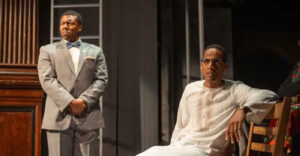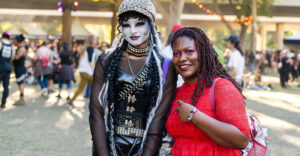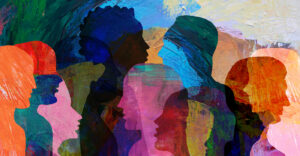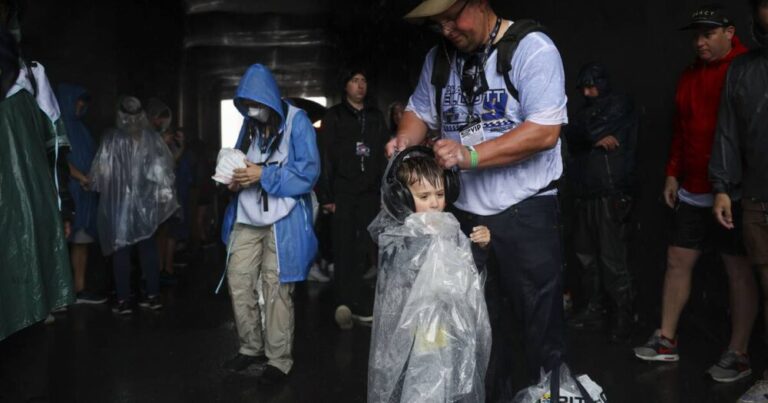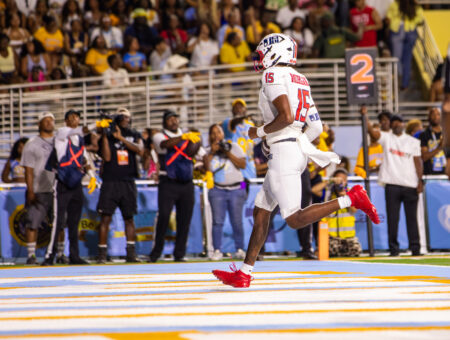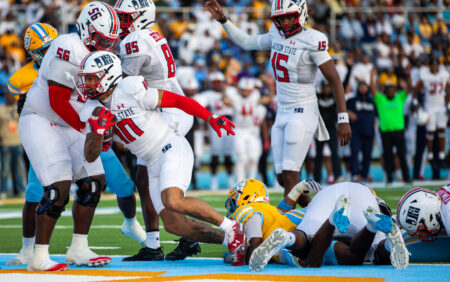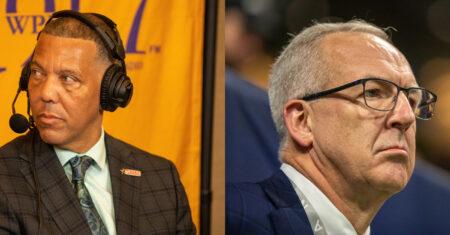Notice: Trying to get property 'post_title' of non-object in /home/ofzfvenynm4q/public_html/wp-content/plugins/wp-rss-feed-to-post/includes/wprss-ftp-display.php on line 109
NASCAR’s first-ever street race came to Chicago and brought with it a tumultuous weekend filled with ups and downs. A man died by electrocution while setting up the event. Three of the five concerts and one of the two races were never completed. The main event was truncated, drivers crashed more than normal due to tight turns, and fans complained about poor communication on weather updates.
And yet, in the end, visitors packed the stands and swarmed Michigan Avenue to get a glimpse of a heart-pounding event underneath a light pink Chicago summer sky on a historic night.
Perhaps the biggest success story from the past weekend came in the form of a controversial piece of metal that no one can see, has caused headaches in the car racing industry and most fans have no idea exists.
Meet the muffler, the new bad boy of NASCAR.
For races on oval tracks in nonurban environments, technicians optimize for speed, throwing noise concerns to the wind and limiting every unnecessary ounce from their chariots. But as NASCAR tries to reach new audiences through street races like the one this past weekend in Chicago, noise has become exceedingly important. The sound output that can reach 130 dBA close to the tracks just won’t do.
The Tribune even spoke with an independent bookstore on South Michigan Avenue that cited noise as a reason for closing its store on an otherwise busy weekend.
For the Chicago street race, NASCAR worked to assuage noise concerns from local businesses and nearby residents by mandating that all cars be fitted with mufflers to reduce sound emissions. Mufflers were first used in a NASCAR Cup Series at the Busch Light Clash at the Coliseum in Los Angeles in February.
“It’s been a big, tremendous amount of work,” said Michael Kelley, who is the crew chief for the No. 47 Chevrolet Camaro driven by Ricky Stenhouse Jr. in the NASCAR Cup Series. “In the long run, it’s probably the right thing to do.”
[ NASCAR Chicago Street Race: How the inaugural event unfolded, from course design to finish line ]
Kelley said NASCAR asked muffler manufacturers to develop and install a muffler that would knock 10 decibels off the sound emissions for urban races like the ones in Los Angeles and Chicago. The difficulty was in trying to figure out how to fit a large chunk of metal underneath an already compact car that is sealed in the bottom to increase aerodynamics. They achieved the 10-decibel drop at the cost of losing “10 to 12 horsepower.”
“Do I think it’s perfect? No,” Kelley said. “We’re trying to respect and handle the decibel side, but you also have 230-degree exhaust temperatures right underneath the driver now.”
During the race, the Tribune visited businesses in the Loop and areas around the track with a decibel reader to detect whether the sound pervaded businesses and affected people who were visiting the area.
At 6:55 p.m. Sunday, a little more than an hour into the race, a family ate deep-dish pizza at Fontano’s Sub and Italian Cafe outside on the corner of Michigan Avenue and Van Buren Street. Across Michigan, cars raced by at 120 mph. The decibel levels maxed out at 101 dBA, which stands for “decibels A,” a calculation system that is used to quantify the sounds that register to the human ear.
A 101 dBA resembles the sound of an approaching subway train, according to the Centers for Disease Control and Prevention. Hearing loss is possible after 15 minutes of sounds at this level. For the people outside, though, during the 90 seconds in which the cars stormed by, they wore gleeful smiles and strained their necks to see the track rather than covering their ears.
During the course of the evening, the closest place for nonpaying viewers on Michigan averaged around 97 dBA when cars drove by, aided in part by the fact the cars had to slow to take the bend at Congress Plaza.
For comparison, during a concert featuring the Chicago native JC Brooks Band, the front row achieved a 96 dBA — considered relatively low for a concert — in part because the performance was before an incredibly small crowd. Hearing experts say concerts like Lollapalooza can reach 115 dBA.
On Michigan, the tourists who weren’t tearing at the black canvas that blocked views of the race walked briskly into the Loop to avoid the commotion. But for others, the sound is a big part of NASCAR’s appeal.
“When I get in the stands and I hear the cars go, it gives me goose bumps,” said Kathy MacLeod from Ann Arbor, Michigan, who enjoyed a hot dog in one of the dining tents by the track. “So many memories of growing up and going from track to track. I’m so excited.”
NASCAR’s traditional oval track races tend to reach noise levels in the 120s and 130s, which is similar to standing directly next to a siren. This can cause damage to the ear very quickly.
Chicago’s street race was much quieter, partially because of the mufflers. But conditions also contributed, including the wet ground and tight turns that accompany most street races as they fit within the confines of city streets. Cars slow significantly on these tight turns, which reduces noise.
Additionally, the narrow streets mean fewer cars can run abreast, which leads to fewer loud cars revving all at once and, instead, longer periods of lower sounds.
Inside Miller’s Pub on Wabash Avenue, diners would have had no idea there was a NASCAR race two blocks away if it wasn’t for a majority of the screens replaying the most recent crash.
“Even if we couldn’t see anything, I just wanted to hear it, kind of feel it, that roar … feel those fully loaded beasts,” Gil Pena of Berwyn said while cleaning his plate. “Hearing that ‘reeeaaarrr,’ that’s all I wanted.”
The restaurant stayed at 72 dBA on average around 7:20 p.m. Sunday. The loudest it got was 78, which came when fans whooped and hollered while they watched a multicar pileup. The cars could not be heard inside the restaurant, drowned out by the customers and the music.
Outside Miller’s, the cars could be heard making the turn just in front of the Art Institute, bringing the sound to a 76, moderately above the normal traffic and occasional honking that triggered a 71 dBA. The decibel reader jumped when an ambulance drove by with its sirens on, registering a 98.
Without the mufflers, the city would have experienced more disruption, according to NASCAR and the muffler manufacturers, who said a 10 dBA increase is significantly more irritating and even dangerous. On the steps of Art Institute, the noise of the cars turning was 96 dBA. This level can cause hearing damage after 50 minutes, while 10 more decibels could cause hearing damage in less than five minutes.
The cars sounded the loudest at the green flag at the start and finish, when all 40 cars were full blast on the straightaway. The sounds registered around a 112, a decibel level that can cause hearing loss in less than two minutes.
One aspect of the race that appeared to be an oversight was that earplugs were not being passed out to attendees.
Kelly, NASCAR spokespeople and other race statisticians estimated that roughly 80% of the people attending were new to the sport, so several vendors capitalized on the opportunity to sell earplugs to those who were unaware of how loud the race could get.
Directly above the racetrack was the Richardsonian Romanesque-style Fine Arts Building on Michigan Avenue between Van Buren Street and Ida B. Wells Drive. Inside, the Studebaker Theater was closed because of traffic issues caused by NASCAR, and the bookstore Exile in Bookville closed partially because of the noise. Here, the meter moved between 57 dBA and 66 dBA depending on where the cars were on the track.
The first number is completely safe and is likened to a normal conversation, while the latter rating is similar to a washing machine that can make you “feel annoyed,” according to the CDC. Ten more decibels is similar to annoying city traffic.
Benjamin Clark owns LH Selman Ltd., a shop that sells glass paperweights on the second floor of the Fine Arts Building. He said the sound would have been “annoying” had they not planned for it and hosted an event at the same time to compete with the noise. His main concern was potential rattling of the glass products in their cases.
After the race got underway, he said, his nerves calmed.
“Nothing shifted at all. And honestly when a bus goes by it can have a louder and larger vibration for us,” he said. With his fan running and chatter from customers attending his event, his showroom was around 66 dBA while the cars passing by on the route’s bend registered a 70.
Still, residents said they were negatively affected by the race.
“We’ve gotten complaints from residents who live around the park,” said Leslie Recht, who is the president of the Grant Park Council. “When we’ve raised these issues with Lollapalooza, with NASCAR, with other people, the problem is that there isn’t an ‘official’ decibel level being taken by some neutral governmental authority or some neutral entity.”
[ NASCAR in Chicago was ‘a commercial for the city,’ but is it worthy of a 2024 repeat? ]
The Chicago noise ordinance — which NASCAR was required to follow pursuant with its contract with the Chicago Park District — has specific sound rules for individuals. Yet the contract states that “the limits set forth in (the noise and vibration control ordinance within the Chicago municipal code) do not apply between the hours of 8:00 am and 10:00 pm to a person participating in a public assembly … or special event .. provided that a permit has been issued.”
The contract granted such a permit to NASCAR, and no cars drove outside the acceptable hours. The event wrapped well before the 10 p.m. mark, in large part because of the weather, which led to the cancellation of the nighttime concerts.
The noise level is just one of the many concerns residents and businesses have with the event. Closed streets, the Grant Park takeover, the pushing of Taste of Chicago to September and questions about how much the city stands to gain all remain.
But when it comes to noise, this past weekend confirmed the city’s annual Air and Water Show is still public enemy No. 1.
